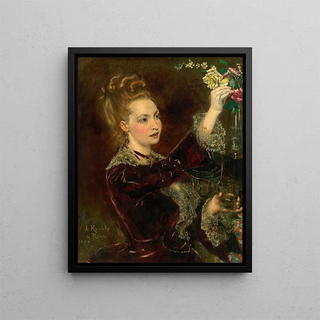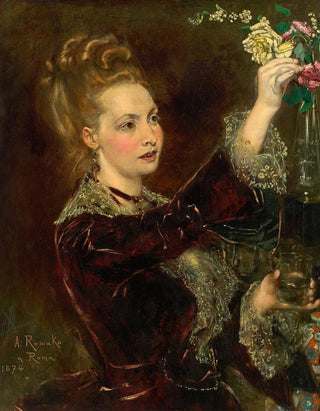Painting Elisabeth von Nast-Kolb née Hardegg - Anton Romako | Art print


View from behind

Frame (optional)
Anton Romako's artwork "Elisabeth von Nast-Kolb née Hardegg" is a true invitation to immerse oneself in the intimacy of a bygone era, where portraiture was the supreme art of social and personal representation. This painting, imbued with rare delicacy, evokes not only the beauty of its model but also the spirit and aspirations of a rapidly changing aristocracy. By contemplating this art print, the viewer is transported into a universe where every detail matters, where light caresses the delicate features of Elisabeth's face, revealing an emotional depth that transcends time.
Style and uniqueness of the art print
Anton Romako's style is distinguished by striking realism, combined with an impressionist touch that gives his works a unique atmosphere. In this portrait, the color palette chosen by the artist plays a fundamental role, oscillating between soft hues and subtle contrasts that highlight the grace of her model. The meticulous details, such as the reflections in Elisabeth's eyes or the texture of the fabrics surrounding her, testify to undeniable technical mastery. Romako manages to capture not only the physical appearance of his subject but also her essence, her character. This portrait is thus much more than a simple representation; it becomes a window into the soul of the woman it depicts.
The artist and his influence
Anton Romako, born in 1832, is an emblematic figure of 19th-century Austrian art. Trained at the Academy of Fine Arts in Vienna, he established himself as a preferred portrait artist, attracting the attention of the aristocracy and intellectual circles of his time. His innovative approach to portraiture, which combines tradition and modernity, influenced many contemporary artists and left a lasting mark on the artistic landscape. Romako does not merely reproduce reality; he elevates it, seeking to establish a dialogue between the subject and the observer. His art print "Elisabeth von Nast-Kolb née Hardegg" perfectly illustrates this quest for depth and authenticity, making it

Matte finish

View from behind

Frame (optional)
Anton Romako's artwork "Elisabeth von Nast-Kolb née Hardegg" is a true invitation to immerse oneself in the intimacy of a bygone era, where portraiture was the supreme art of social and personal representation. This painting, imbued with rare delicacy, evokes not only the beauty of its model but also the spirit and aspirations of a rapidly changing aristocracy. By contemplating this art print, the viewer is transported into a universe where every detail matters, where light caresses the delicate features of Elisabeth's face, revealing an emotional depth that transcends time.
Style and uniqueness of the art print
Anton Romako's style is distinguished by striking realism, combined with an impressionist touch that gives his works a unique atmosphere. In this portrait, the color palette chosen by the artist plays a fundamental role, oscillating between soft hues and subtle contrasts that highlight the grace of her model. The meticulous details, such as the reflections in Elisabeth's eyes or the texture of the fabrics surrounding her, testify to undeniable technical mastery. Romako manages to capture not only the physical appearance of his subject but also her essence, her character. This portrait is thus much more than a simple representation; it becomes a window into the soul of the woman it depicts.
The artist and his influence
Anton Romako, born in 1832, is an emblematic figure of 19th-century Austrian art. Trained at the Academy of Fine Arts in Vienna, he established himself as a preferred portrait artist, attracting the attention of the aristocracy and intellectual circles of his time. His innovative approach to portraiture, which combines tradition and modernity, influenced many contemporary artists and left a lasting mark on the artistic landscape. Romako does not merely reproduce reality; he elevates it, seeking to establish a dialogue between the subject and the observer. His art print "Elisabeth von Nast-Kolb née Hardegg" perfectly illustrates this quest for depth and authenticity, making it
12,34 €






